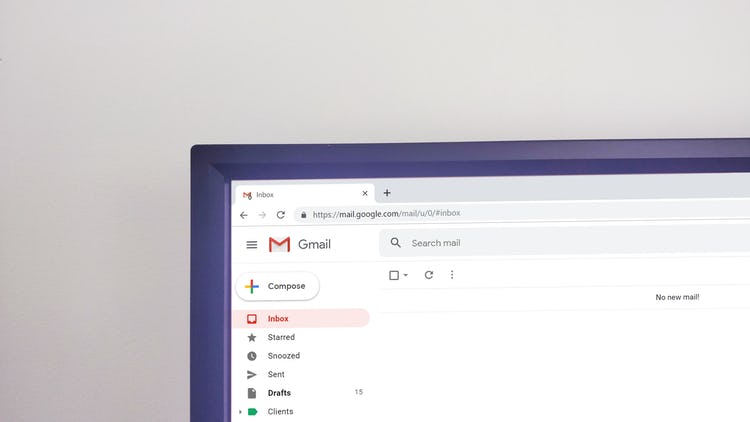20 Email Etiquette Rules for Professional Success
Mastering professional email communication is one of the most important skills you can develop for your academic and professional life. Unlike a quick text or a social media comment, a professional email follows a certain set of rules that show respect, competence, and attention to detail.

Every professional email you send builds your personal brand and reputation, so it's worth getting it right.
How you write your emails can have a real impact on your success. Hiring managers, professors, and colleagues form opinions about you based on your emails. Good email skills can help you:
- Succeed in school: Communicate clearly with professors and advisors.
- Advance your career: Build professional relationships and land job opportunities.
- Build your personal brand: Be known as a competent and reliable communicator.
- Network effectively: Make meaningful professional connections.
Bad email habits can hold you back, even if you're highly qualified. On the other hand, great email skills can open doors. This guide will give you proven strategies to turn your digital communication into a professional asset.
The Basics of Strategic Emailing
Before we get into the nitty-gritty, let's cover the fundamentals of when and how to use email effectively.
1. Know When to Email—and When Not To
Email isn't always the best tool for the job. Before you start typing, ask yourself if email is the right choice.
When to pick up the phone or talk in person:
- For urgent matters: A phone call is much faster.
- For complex discussions: A real-time conversation can prevent misunderstandings.
- For sensitive or emotional topics: Face-to-face is always better for these.
- For a quick question to someone nearby: A quick chat can be more efficient and build rapport.
Use email for documenting decisions, sharing information that needs to be reviewed, coordinating schedules, or communicating with a group.
2. Write a Clear, Specific Subject Line
Your subject line is your first impression. It can determine whether your email gets opened, prioritized, or ignored.
Good subject line examples:
- "Meeting Request: Project Alpha Strategy - March 15th"
- "Following Up: Wednesday's Client Presentation"
- "Action Required: Budget Proposal Review by Friday 5 PM"
- "Question About the Summer 2024 Internship Application"
Bad subject line examples:
- "Hey!" or "Quick question" (too informal)
- "FYI" or "Update" (too vague)
- "URGENT!!!" (use sparingly to be taken seriously)
- (No subject line) (looks unprofessional and might get flagged as spam)
If you're emailing a professor, it's a good idea to include your class and section, like: "Sarah Chen - Biology 301, Tuesday Lab: Question About Lab Report."
3. Use a Professional Email Address
Your email address is your digital business card. Make sure it reflects a professional image.
Good email address examples:
Unprofessional email addresses to avoid:
If your personal email isn't professional, create a new one just for school and work. It's also a good idea to create a professional email signature with your full name, title, and contact information.
Structure and Tone
A well-structured email with a professional tone is easier to read and more likely to get a positive response.
4. Start with a Proper Greeting
A professional greeting sets the tone for your entire email. The formality depends on your relationship with the recipient.
Formal greetings (for first contact or senior professionals):
- "Dear Dr. Johnson,"
- "Dear Professor Martinez,"
- "Dear Mr. Thompson,"
- "Dear Ms. Anderson,"
Slightly less formal (for ongoing relationships):
- "Hello Dr. Peterson,"
- "Good morning, Professor Williams,"
- "Hi Sarah," (only if they've indicated a first-name basis is okay)
When in doubt, err on the side of formality. Never use "To Whom It May Concern" if you can find a specific name. A little research goes a long way.
5. Briefly Introduce Yourself and the Context
Don't assume the recipient remembers you. Provide a brief reminder of who you are and why you're writing, especially if you're emailing a busy professor or a new contact.
Good introduction examples:
- "I'm a sophomore in your Tuesday morning Genetics course."
- "We met at the Career Fair last week, and you suggested I reach out about internship opportunities."
- "I'm following up on our conversation at the Chicago conference about research collaboration."
This helps the recipient quickly understand why your email is important and how to respond.
6. Use Professional Language
Professional emails should be written in complete sentences with proper grammar and punctuation. Avoid slang, text-speak, and an overly casual tone.
What to do:
- Use full words (you, not u; please, not pls).
- Use proper capitalization and punctuation.
- Make polite requests ("Could you please...") instead of demands ("Send me...").
What to avoid:
- Texting abbreviations (LOL, BRB, TTYL).
- Excessive exclamation points.
- Overly stiff or robotic language. It's okay to use contractions (I'm, you're) to sound natural.

A professional email should guide the reader logically from a polite greeting to a clear call to action.
Content and Clarity
Respect your recipient's time by making your emails clear, concise, and easy to act on.
7. Keep It BRIEF
Use this simple framework to structure your emails:
B - Brief opening: State your purpose in the first sentence. R - Reason: Explain why you're writing. I - Information: Provide all the necessary details. E - End: Specify what you need from the recipient. F - Friendly closing: Thank them and sign off politely.
8. Be Concise
Busy people appreciate short, to-the-point emails.
General length guidelines:
- Simple requests: 50-100 words.
- More complex topics: 150-250 words, broken into short paragraphs.
- Follow-ups: 25-75 words.
If your message is getting long, consider a phone call or meeting instead.
9. Use Formatting to Improve Readability
Make your emails easy to scan with good formatting.
- Use bullet points for lists.
- Keep paragraphs short (2-4 sentences).
- Use bold text sparingly for key information.
- Leave plenty of white space.
Avoid using multiple fonts, crazy colors, or all caps (which looks like you're shouting).
10. Include All Necessary Information
Think ahead and provide all the details the recipient will need to respond. This will save you both a lot of back-and-forth.
Checklist of what to include:
- Specific dates, times, and locations.
- Relevant deadlines.
- Your contact information.
- Any necessary attachments or links.
- A clear explanation of what you need.
Advanced Email Strategies
These skills will set you apart as an exceptional communicator.
11. How to Disagree Politely
In a professional setting, you'll sometimes need to express disagreement. Do it respectfully.
- Acknowledge the other person's point of view first.
- Use "I" statements to express your perspective.
- Focus on shared goals and data, not personal opinions.
- Suggest a collaborative solution.
Example: "I appreciate your analysis of Option A. I'm wondering if we could also consider Option C, which might address the budget concerns we discussed. Would you be open to exploring that?"
12. Managing Difficult Conversations
For tricky situations, a little strategy goes a long way.
- Draft now, send later: If you're feeling emotional, write a draft but wait 24 hours before sending it.
- Ask for clarification: Make sure you understand the other person's position before you respond.
- Focus on solutions, not blame.
- Suggest a call or meeting for complex issues.
13. The Art of the Follow-Up
A strategic follow-up shows you're reliable and engaged.
When to follow up:
- Immediately: To confirm you received something important.
- 24-48 hours: After a meeting or interview.
- One week: For non-urgent requests that haven't gotten a response.
- Monthly: To stay in touch with mentors or networking contacts.
14. Handle Attachments Like a Pro
- Use descriptive file names (e.g., "Johnson_Resume_Marketing_Position_2024.pdf").
- Send files in a universal format like PDF.
- Keep file sizes small (under 10MB).
- Mention the attachment in the body of your email.
For large files, use a cloud sharing service instead.
15. Perfect Your Email Signature
A professional signature provides essential contact information and reinforces your brand.
What to include:
- Full name and title/degree program.
- Institution or company.
- Phone number and email address.
- LinkedIn profile URL.
Keep it concise (4-6 lines) and avoid graphics or quotes.

Good email management includes strategic follow-ups, professional file sharing, and a consistent signature that reinforces your professional image.
Security and Boundaries
Good email etiquette also means being mindful of privacy and your own well-being.
16. Keep It Confidential
- Never share confidential information without permission.
- Use BCC for group emails to protect recipients' privacy.
- Double-check the "To" field before you hit send.
Remember that work and school emails can be monitored.
17. Understand the Legal and Ethical Side
- Emails can be used as legal evidence.
- Be aware of your organization's policies on email retention.
- Always be respectful and professional, even in difficult situations.
Write every email as if it could be forwarded to someone else.
18. Set Healthy Boundaries
- You don't have to be available 24/7. Set specific times to check and respond to emails.
- Use an auto-reply when you're on vacation.
- It's okay to take 24-48 hours to respond to non-urgent messages.
19. Handle Group Emails with Care
- Use "Reply All" sparingly. Does everyone on the chain really need to see your response?
- If your reply is just for one person, take them off the group thread.
20. Keep Improving
Like any skill, email communication gets better with practice.
- Ask for feedback from mentors or colleagues.
- Pay attention to emails you receive from people you respect. What do they do well?
- Practice new techniques in low-stakes situations.
Turning Your Email Skills into a Professional Advantage
Great email skills can be a real career differentiator. By mastering these techniques, you'll build stronger relationships, get more opportunities, and be seen as a true professional.
Start by focusing on a few areas where you can improve. Small changes can make a big difference over time. Remember that every email you send is a reflection of you. Make sure it's a good one.
Related Articles
Having a rich vocabulary is a cornerstone of great writing, no matter what you're writing about. It’s not just about collecting words; it’s about being able to...
An argumentative essay is one of the most rewarding—and challenging—assignments you’ll tackle in school. It’s not just about sharing your opinion. You need to t...
Great writing isn't a special talent for a chosen few—it's a skill you can build with the right practice and techniques. Whether you're struggling with school p...
